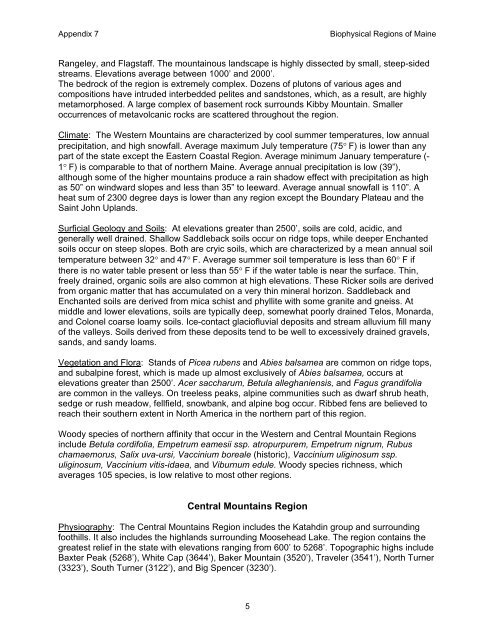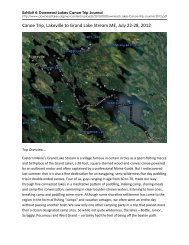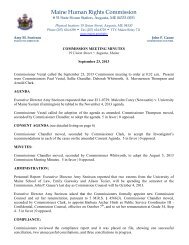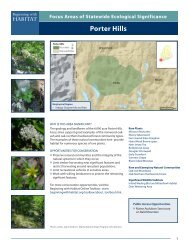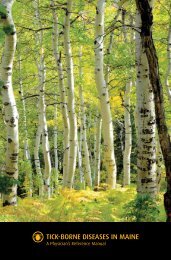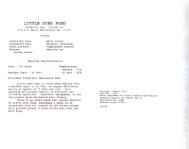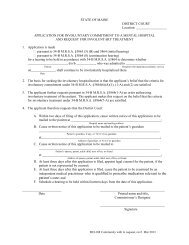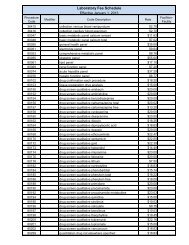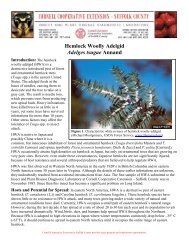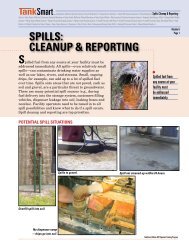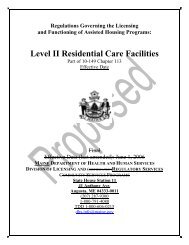BIOPHYSICAL REGIONS - Maine.gov
BIOPHYSICAL REGIONS - Maine.gov
BIOPHYSICAL REGIONS - Maine.gov
You also want an ePaper? Increase the reach of your titles
YUMPU automatically turns print PDFs into web optimized ePapers that Google loves.
Appendix 7 Biophysical Regions of <strong>Maine</strong><br />
Rangeley, and Flagstaff. The mountainous landscape is highly dissected by small, steep-sided<br />
streams. Elevations average between 1000’ and 2000’.<br />
The bedrock of the region is extremely complex. Dozens of plutons of various ages and<br />
compositions have intruded interbedded pelites and sandstones, which, as a result, are highly<br />
metamorphosed. A large complex of basement rock surrounds Kibby Mountain. Smaller<br />
occurrences of metavolcanic rocks are scattered throughout the region.<br />
Climate: The Western Mountains are characterized by cool summer temperatures, low annual<br />
precipitation, and high snowfall. Average maximum July temperature (75° F) is lower than any<br />
part of the state except the Eastern Coastal Region. Average minimum January temperature (-<br />
1° F) is comparable to that of northern <strong>Maine</strong>. Average annual precipitation is low (39”),<br />
although some of the higher mountains produce a rain shadow effect with precipitation as high<br />
as 50” on windward slopes and less than 35” to leeward. Average annual snowfall is 110”. A<br />
heat sum of 2300 degree days is lower than any region except the Boundary Plateau and the<br />
Saint John Uplands.<br />
Surficial Geology and Soils: At elevations greater than 2500’, soils are cold, acidic, and<br />
generally well drained. Shallow Saddleback soils occur on ridge tops, while deeper Enchanted<br />
soils occur on steep slopes. Both are cryic soils, which are characterized by a mean annual soil<br />
temperature between 32° and 47° F. Average summer soil temperature is less than 60° F if<br />
there is no water table present or less than 55° F if the water table is near the surface. Thin,<br />
freely drained, organic soils are also common at high elevations. These Ricker soils are derived<br />
from organic matter that has accumulated on a very thin mineral horizon. Saddleback and<br />
Enchanted soils are derived from mica schist and phyllite with some granite and gneiss. At<br />
middle and lower elevations, soils are typically deep, somewhat poorly drained Telos, Monarda,<br />
and Colonel coarse loamy soils. Ice-contact glaciofluvial deposits and stream alluvium fill many<br />
of the valleys. Soils derived from these deposits tend to be well to excessively drained gravels,<br />
sands, and sandy loams.<br />
Vegetation and Flora: Stands of Picea rubens and Abies balsamea are common on ridge tops,<br />
and subalpine forest, which is made up almost exclusively of Abies balsamea, occurs at<br />
elevations greater than 2500’. Acer saccharum, Betula alleghaniensis, and Fagus grandifolia<br />
are common in the valleys. On treeless peaks, alpine communities such as dwarf shrub heath,<br />
sedge or rush meadow, fellfield, snowbank, and alpine bog occur. Ribbed fens are believed to<br />
reach their southern extent in North America in the northern part of this region.<br />
Woody species of northern affinity that occur in the Western and Central Mountain Regions<br />
include Betula cordifolia, Empetrum eamesii ssp. atropurpurem, Empetrum nigrum, Rubus<br />
chamaemorus, Salix uva-ursi, Vaccinium boreale (historic), Vaccinium uliginosum ssp.<br />
uliginosum, Vaccinium vitis-idaea, and Viburnum edule. Woody species richness, which<br />
averages 105 species, is low relative to most other regions.<br />
Central Mountains Region<br />
Physiography: The Central Mountains Region includes the Katahdin group and surrounding<br />
foothills. It also includes the highlands surrounding Moosehead Lake. The region contains the<br />
greatest relief in the state with elevations ranging from 600’ to 5268’. Topographic highs include<br />
Baxter Peak (5268’), White Cap (3644’), Baker Mountain (3520’), Traveler (3541’), North Turner<br />
(3323’), South Turner (3122’), and Big Spencer (3230’).<br />
5


